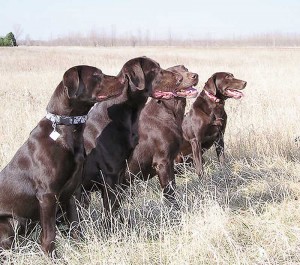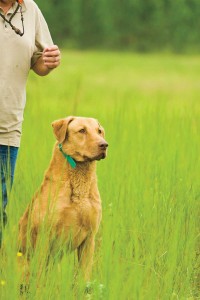 Strictly speaking, the term "release command" is an oxymoron. A dog is either on command or has been released from command. He can't be both. So whatever expression one uses to release his pooch isn't really a command, but retrieverites have called it one for so long it'd be pointless to try to change it. Thus I'll call it a command here.
Strictly speaking, the term "release command" is an oxymoron. A dog is either on command or has been released from command. He can't be both. So whatever expression one uses to release his pooch isn't really a command, but retrieverites have called it one for so long it'd be pointless to try to change it. Thus I'll call it a command here.
You have numerous actual commands with which to direct your dog along the road of responsible retriever reactions: Sit, Stay, Heel, Come, Back, Over, Fetch and Give. You have one term to both get his attention and send him on a marked retrieve: his call name ("Blackie," "Goldilocks," "Dead-Grass" or whatever).
You've got several corrective expressions to highlight his occasional behavioral lapses: No, Hush and perhaps a few that a family-oriented magazine shouldn't publish. After you and your pooch have worked together awhile, he'll understand these verbal communications quite well, without any misunderstandings.
You also have several terms of praise for proper behavior: Good Dog, Atta-Boy and so on. Your dog learned to understand their complimentary meaning quite rapidly. However, he may add one unintended meaning, namely freedom from whatever command he has obeyed so well. You command Sit, and he sits, then you say "Good dog," and he jumps up, wags all over and wants to play. Not what you meant.
Many years ago, this confusion led some trainers to believe that they should never praise or pet their dogs because it made them "lose control." They trained negatively and their dogs worked as if trained by Attila the Hun in a bad mood.
Look at it from the dog's point of view. Without a specific release command, he has to figure out on his own when a given command expires and thereafter no longer applies. He usually does this by studying the boss's body and verbal languages. And what could better signify release than verbal or physical praise?
However, as far back as I can remember — like when Caesar and I were running channel blinds up and down the Rubicon — savvy trainers have known that by teaching a separate release command, they could eliminate all canine confusion about the significance of praise. They could train positively and their dogs would work confidently, happily, ergo stylishly.
So, if you teach your retriever a separate release command and he learns that command alone releases him from any previous instructions, you can praise and pet him lavishly with no risk of losing control.
Teach the Cease
Different people use different words for a release command, like Okay, Free, Hie On and even School's Out. Of course, if you wish, you can make up your own, even from nonsense syllables. Here I'll use Okay.
Theoretically, you can't teach the release command until after you've taught your pooch at least one control command from which to release him. But actually you can teach it in conjunction with your pup's first control command, normally Sit.
Say "Sit" and put him into a sitting position. For this, you can simply push down on his rump with one hand while holding his chin up with the other. Obedience trial trainers prefer not to push the rump down because it can confuse the dog later in the "Stand for Examination" exercise, when he must remain standing while being thusly pushed.
Back when I was doing obedience trials — with my two training buddies, Mark Antony and that gorgeous Liz Taylor look-alike, Cleopatra — we tapped the pup's rump down.
More recently, some "totally positive training" loonies have condemned both pushing and tapping as negative. Instead, they wave a treat around over the pup's head until he leans back and sits. In Cicero's oft-quoted words, "O Tempora! O Mores!" (What times! What customs!)
Hold your pup in a sitting position a few seconds while praising him. Then say "Okay," and help him back up onto his feet. Praise him again and play with him awhile before repeating this exercise. Repeat it several times a day. Before long, when you say "Sit," your pup will plunk it down and look at you for praise. So praise him! If he moves, say "No" and put him back into a sitting position — and then praise him (very important). Wait a few seconds before releasing him with "Okay," and once again praise him.
When he's reliable while you're standing next to him, snap on a lead and start backing away before commanding "Sit." If he refuses, go to him, put him into a sitting position, praise him, back away and praise him again. If he gets up, say "No," put him back in a sitting position, praise him, back away again and praise him again. After a few seconds, say "Okay" and praise him when he gets up.
Eventually, even when you're quite some distance away, he'll sit on your command and remain in place, while you praise him, until you say "Okay." (When you reach this point, you should start using the Sit-whistle as well as the verbal command. But that's another topic.)
Then, you should introduce this command-praise-release-praise sequence into other basic obedience commands, like Heel, Come and Stay. By the time you finish basic obedience, your pooch will have acquired a mass of incontrovertible empirical evidence demonstrating that your release command, and only your release command, frees him from your previous control command.
He'll understand that praise is just a reward for good work, not a release from control. This will allow you to train in a predominantly positive manner ever thereafter. Sure, you'll have to correct him sometimes, but you'll always have praise available for rewarding good work. He'll work for your praise, and his anticipation of it will bring out as much style as his genes possess.
 Other Uses
Other Uses
Perhaps your most frequent use of the release command will be in giving your dog "fun dummies" to end training sessions on a happy note. Let him break and chase fun dummies, which without a release command would quickly unsteady him.
Holler "Okay!" several times as you swing a dummy around over your head. He'll race around you watching the dummy. Toss it long and high as you again holler "Okay!" He'll chase so hard that he might occasionally catch the dummy in mid-air! Fun dummies will perk your dog up, and remembering these exhilarating session-ending pleasantries will make him eager for the next session.
When you e-collar-condition your retriever, your ability to reassure him with praise will help him get through this sometimes stressful training procedure. The sequence — command, nick or burn, praise — helps your dog understand what's going on much better than does a sequence of command, nick or burn and silence.
When you force-fetch him, your power to praise without release will also make this process less frustrating. The sequence — Fetch, pinch (or nick/burn), praise...Give, praise — speeds this process up and makes it more positive. (For your own force-fetch stress, I recommend a post-session martini!)
When you advance into blind retrieve training, you'll find several uses for praise. For example, let's say your dog "slips a whistle" (refuses to stop and sit on the Sit-whistle). You first send him an electronic correction, after which he plunks it down properly. If you immediately holler your favorite terms of endearment, he'll find the experience both educational and positive.
When you're hunting upland birds together, your dog will sometimes start trailing a track-star pheasant.
As he does, each time he gets too far ahead of you, stop him with the Sit-whistle and have him wait while you catch up. As you approach him, praise him with "Good dog, good dog, good dog." Then, when you've caught up, release him to resume trailing with "Okay!"
You may do this stop-and-go pheasant trailing for some distance, through all sorts of cover, and eventually see the bird flush just a few yards ahead. When you shoot that bird and your pooch retrieves it, you'll both feel a special bond that such teamwork usually produces. (If you miss the bird, your dog won't blame you, thereby humbling and making you more tolerant of his mistakes.)
As you and your retriever go through the years of his active life, you'll find many other occasions when you'll be glad you taught him a distinct release command, thereby preventing him from confusing praise with release.
Enjoy!
Jim Spencer's books can be ordered from the Gun Dog Bookshelf: Training Retrievers for Marshes & Meadows; Retriever Training Tests; Retriever Training Drills for Marking; Retriever Training Drills for Blind Retrieves; Retriever Hunt Tests; HUP! Training Flushing Spaniels the American Way; and POINT! Training the All-Seasons Bird Dog.






